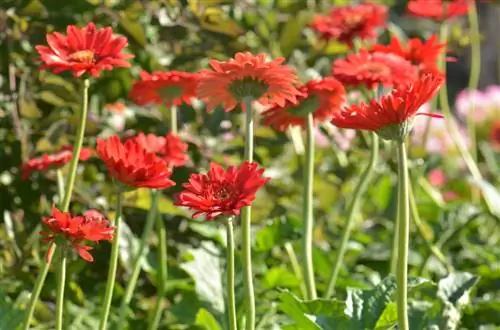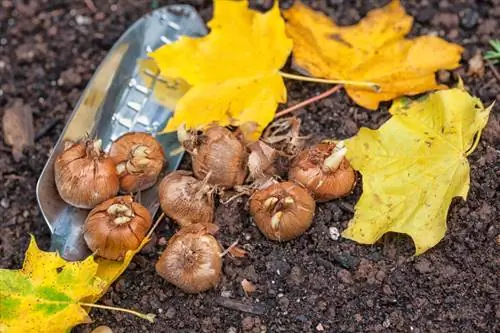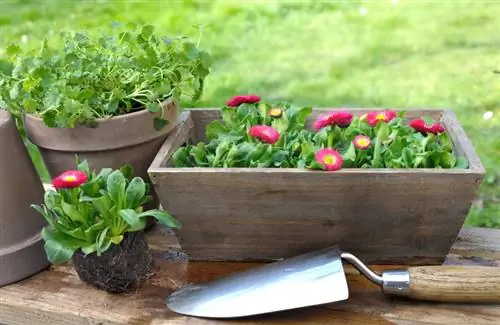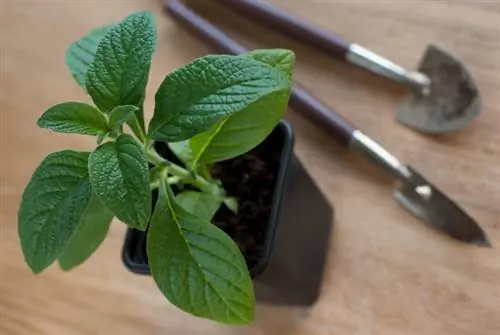- Author admin [email protected].
- Public 2024-01-02 03:03.
- Last modified 2025-06-01 06:02.
Who doesn't love the daisy? Herald of spring, long-lasting bloomer, lovely gap filler, lawn ornament - the list of its advantages is long. Reason enough to take a closer look at the cultural conditions for the two-year-old millennium. These answers to basic questions offer a good start.

What characterizes daisies?
Daisies are popular, easy-going flowers with a long blooming period from March to November. They thrive both in the garden and in pots and tolerate sunny to semi-shady locations. As an edible and healing plant, they can also be used in many different ways.
Planting daisy flowers correctly
While the wild daisy even settles on ruderal areas, cultivated varieties place somewhat higher demands on the location. It is preferable to plant the daisy in a sunny to semi-shady place with humus-rich, well-drained soil. Wait and see for the ice saints, because frosty temperatures don't suit grown-to-measure sweethearts at all. This is how you properly plant home-grown or ready-made daisies:
- Rake and weed the soil thoroughly
- Meanwhile, soak the still potted Bellis in water
- Dig planting holes with 1.5 times the volume of the root ball
- Enrich the excavation with sifted compost
- Plant the potted daisies 12 centimeters apart
Finally, press the soil with your hands and water generously without causing waterlogging. Until the sweethearts have firmly established themselves in the substrate, regular watering plays an important role.read more
When is flowering time?
When it comes to flowering time, a distinction must be made between the wild form and the cultivated varieties that emerged from it. The wild daisy scores with an uninterrupted flowering period from March to November. In mild winters, it even decorates the lawn, bed and flower box all year round. The noble varieties delight us with their dense blooms from May to September.read more
Daisy flowers in a pot
In pots, daisies become a pretty eye-catcher on the balcony, terrace or windowsill. If you give this care to the loving ones, this form of cultivation will proceed as desired:
- If the substrate dries, it is watered
- Provide with diluted liquid fertilizer every 14 days
- Cleaning up dead flowers extends the flowering period by weeks
Commercial compost-based potting soil is ideal as a substrate. If you cover the water drain with a piece of clay when planting, this drainage prevents harmful waterlogging.read more
Is daisy poisonous?
The daisy is not only pretty to look at, but also quite tasty. It is above all the wild daisy beauty that pampers the palate as an addition to salads or as an aromatic decoration for dishes. With herb quark, the curd is a wonderful treat. In addition, the delicate flower acts as a natural medicinal plant against many ailments. So there can be no question of it being poisonous.
The Spanish daisy, however, is an exception. Despite its name, this species is one of the fine-beam asters (Erigeron karvinskianus) and is not suitable for consumption.read more
The Daisy Family
The daisy is one of the best-known representatives within the botanical family Asteraceae. Relatives are the daisy, sunflower, chamomile, aster and marigold. Less popular members of this family are the dandelion or thistle, which are more commonly considered weeds.
The blue daisy is likely to be of particular interest as a member of the family. Native to Australia, it thrives on our balcony and overwinters in the hanging basket as a houseplant.
The structure of a daisy
The structure of these little flowers brings it to light: daisies are anything but ordinary flowers. In fact, every single specimen is a miracle of nature. The secret lies in the ingenious structure of a flower. What our eyes perceive as a single flower is actually a combination of numerous individual flowers. White ray florets surround a center of hosts of yellow tubular flowers. In the community, however, they react like a single flower.
When it starts to rain, the ray florets surround the yellow tubular flowers. They do the same thing at night, only to open up again at dawn. In sunny weather the flower turns towards the light.
Daisies in the lawn
In natural gardens, daisies have no longer been considered weeds for some time, but are specifically planted in the lawn. In this way, the tireless little flowers bring a natural splendor of color to a uniform green area. First and foremost, the common daisy (Bellis perennis) has proven to be excellent thanks to its long flowering period. This is how you properly sow daisies in the lawn:
- In March/April, spread the seeds in places or over the lawn
- Covering the light germinators is not absolutely necessary
- Sift 0.5 centimeters high with fine sand and water
At constant temperatures of 15 degrees Celsius and higher, the seeds germinate within 1-2 weeks, so that they emerge before the first lawn mower. The first flowers appear the following spring from March.
Sowing daisies
Since daisies, as biennial plants, only bloom the following year, the cold frame is ideal for sowing. Alternatively, choose a shady, sheltered spot in the garden as a seedbed. The finer the substrate, the more successful germination will be. Follow these steps:
- Time window for sowing is from mid-May to early August
- Spread the seeds widely in the prepared seedbed
- Sift the light germinators very thinly with sand or substrate
- Press lightly and moisten with a fine spray
- Protect with a raffia mat or garden fleece
At 15-20 degrees Celsius, germination takes about 10-14 days. During this time the seeds must not dry out. After emergence, the young plants are pricked to 3 centimeters. In summer, plant the daisies outdoors at a distance of 10-20 centimeters, depending on the variety cultivated.read more
The peculiarities of the daisy
The daisy is characterized by a whole range of interesting features. Each individual flower actually consists of a multitude of white ray florets and yellow tubular florets. Gourmets appreciate the little measure as an addition to salads, an aromatic bread topping and as an edible decoration. As a medicinal plant, the daisy relieves minor ailments in no time.read more
Growing daisies on the balcony
With daisies, your balcony will never be without flower decorations. Thanks to a never-ending flowering period from March to November, the wild species and its cultivated varieties create a colorful appearance in pots and balcony boxes. To achieve this goal, you only need a few criteria for proper planting and care:
- Put cold-sensitive varieties on the balcony only after the Ice Saints
- The substrate should be well-drained and nutrient-rich
- Drainage above the water outlet in the planter is essential
- Regular watering and a dose of liquid fertilizer every 2 weeks are mandatory
Clean out wilted flowers every few days to create space for new flower heads.read more
Overwintering Spanish Daisy
The Spanish daisy owes its name to its white ray flowers with a yellow center. In fact, we also have a daisy family before us, but it belongs to a different genus within this multifaceted plant family. In our latitudes, the Spanish daisy is not completely hardy, so the following protective precautions are advisable:
- Cover in the bed before the first frost with raffia mats or garden fleece
- In mild locations, pile up with leaf mold, straw and needle sticks
The best chances of successful overwintering are in a planter if a bright winter quarters is available with temperatures of 5 degrees and higher. Otherwise, wrap the bucket thickly in bubble wrap or jute and place it on a block of wood in front of the protected south wall of the house. Cover the substrate with a thick layer of straw, sawdust or leaves.read more
destroying daisies
The little one is not always welcome in the garden. First and foremost, hobby gardeners strive to remove the busy, permanent bloomers from the lawn. To destroy daisies, do this:
- Remove individual daisies with the weed cutter
- Scarify a lawn covered in daisies lengthwise and crosswise
- Then sand the green area, fertilize it and reseed bare areas
- Then mow the lawn at least once a week
- Destruct stubborn daisies in the lawn with Celaflor Lawn Weed Free Anicon (€76.00 at Amazon) or Weedex
If daisies are undesirable in the bed, you can't avoid regular weeding. Any means of combating the small flowers will destroy all surrounding ornamental plants at the same time.read more
Picking daisies
Picking daisies and weaving a pretty flower wreath out of them is very easy. Large-flowered noble varieties are better suited for this purpose than the delicate common daisy. Use your fingernail to make a small split in the lower third of the stem. Push the stem of the next sweetheart into this until it reaches under the flower head.
A little tact is required to close the flower wreath. It is important to split the last flower stalk so far that the first flower head can fit through.read more
The daisy species
In addition to the widespread common daisy Bellis perennis, there are other species within the plant genus. The following Bellis species also deserve our attention:
- Bellis longifolia: a daisy native to Crete that is not hardy in our latitudes
- Bellis annuana: the annual daisy grows mainly in the Mediterranean region
- Bellis sylvestris: a shade-tolerant forest flower that blooms in the Mediterranean from June to September
- Bellis cordifolia: a rather inconspicuous species with a flowering period from March to May in Spain and southern France
Other species are named by busy botanists, who, however, cannot hold a candle to the Bellis perennis and its varieties that are native to us in terms of flowering and beauty.read more
- Habanera: a natural beauty with double flowers in white with pink tips
- Bellis Tasso strawberry cream: beautiful pompom flowers in cream and pink
- Floro pleno: full, bright red flowers on sturdy stems
- Nibelungen: stretches its white flower heads up to 20 centimeters high
- Sea of flowers: Spanish daisy with white flowers that bloom pink






